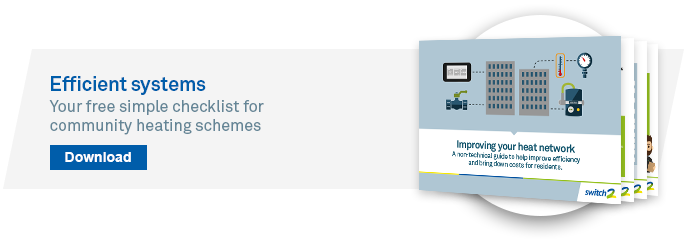Similarly to worker bees, community heating schemes need to be efficient, running to optimum performance in order to ensure quality heat and affordability to end customers (or in the case of bees, ensuring enough food for winter). So what should housing managers consider to improve scheme efficiencies and provide a fair deal for the resident?
It’s no surprise that an efficient community heating scheme will provide greater benefits and a more reliable and consistent service to residents compared to an inefficient heating scheme.
How community heating works
Community heating is a centralised heating system that supplies heat and hot water to one building block with more than one heat customer, according to the Heat Network Regulations.
In the UK most community heating schemes’ heat is generated in a plant room using gas boilers, CHP engines or biomass boilers. In some cases they may be connected to and buy heat from a district heating network.
Understanding the pipework
A community heating plan can be segmented into three areas referred to in the CIBSE Code of Practice for heat networks (CP1) as the primary, secondary and tertiary areas of a network. However, this can be simplified to:
- The plant room – where the heat is generated
- The distribution network – how the heat from the plant room is delivered to the customer (including communal areas)
- The apartment heating systems – the radiators, underfloor heating and domestic hot water supply
Identifying system inefficiencies
Our first and foremost recommendation would be to:
- Survey your scheme
A basic survey of a communal heating scheme (and observing metering data collected for the full building) will outline areas of improvement. A basic survey may consist of looking at each area of the network, taking into consideration the temperature changes of corridors, the level of insulation on bare pipework, to speaking with residents about their understanding of using the system. To get a greater understanding, the findings from the survey can be applied to the data captured by the BEMs and metering system utilised on the network; in turn exposing the locations of heat losses on the network. Our free non-technical checklist is a good start for Housing Managers to use and learn how to improve their system efficiencies.
Problems of poorly performing community heating systems
There are many concerns that may need addressing to make an inefficient community heating system run at optimum performance; for example:
- Lack of insulation on pipework, terminal runs and valves
- Lack of optimisation of return temperatures (the system only using a small chunk of heat that is generated)
- Design oversizing of equipment and pipework
- Not enough measurements and controls in place (this could be metering or using the BEMs)
Bring in the experts
A simple checklist is a good starting point to refining your scheme’s performance. However, you can further identify areas for improvement by bringing in specialists in scheme management. An expert in the field will be able to help by evaluating your scheme’s inefficiencies and provide you with an action plan to optimise your heat network and consequently, give cost savings back to your residents.
A must read: Section 3.9 of the CIBSE guide CP1
The CIBSE Code of Practice CP1 outlines how to achieve an efficient existing communal heating system within a multi-residential building and to reduce risk of overheating. We would highly recommend reading section 3.9 of the Code, as it explains the reasons why heat losses occur, best practice and preventative measures required to run efficient systems.
So, what can we do about existing schemes; can they be improved? In simple terms, yes! But this would be a blog post in its own entirety, which you should look out for in the near future.
And finally, every scheme is different and therefore approaches to improving schemes will vary. However by undertaking simple surveys, and measuring the energy consumed you will make good start to understanding the building block’s requirements and where opportunities for improvement may exist.
Key takeaways
- Prove your losses by utilising surveys and metering data from your communal heating system. If you don’t have the capabilities to do this, bring in the experts to help
- By making improvements to system efficiencies you can help make savings for the resident
- Always measure performance to improve your systems
- Read the CIBSE Code of Practice (CP1) for non-technical advice and minimum standards that you can apply to your communal heating schemes



